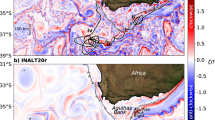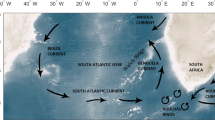Abstract
Investigating the variability of Agulhas leakage, the volume transport of water from the Indian Ocean to the South Atlantic Ocean, is highly relevant due to its potential contribution to the Atlantic Meridional Overturning Circulation as well as the global circulation of heat and salt and hence global climate. Quantifying Agulhas leakage is challenging due to the non-linear nature of this process; current observations are insufficient to estimate its variability and ocean models all have biases in this region, even at high resolution . An Eulerian threshold integration method is developed to examine the mechanisms of Agulhas leakage variability in six ocean model simulations of varying resolution. This intercomparison, based on the circulation and thermohaline structure at the Good Hope line, a transect to the south west of the southern tip of Africa , is used to identify features that are robust regardless of the model used and takes into account the thermohaline biases of each model. When determined by a passive tracer method, 60 % of the magnitude of Agulhas leakage is captured and more than 80 % of its temporal fluctuations, suggesting that the method is appropriate for investigating the variability of Agulhas leakage. In all simulations but one, the major driver of variability is associated with mesoscale features passing through the section. High resolution (\({<} 1/10^{\circ }\)) hindcast models agree on the temporal (2–4 cycles per year) and spatial (300–500 km) scales of these features corresponding to observed Agulhas Rings. Coarser resolution models (\({<} 1/4^{\circ }\)) reproduce similar time scale of variability of Agulhas leakage in spite of their difficulties in representing the Agulhas rings properties. A coarser resolution climate model (\(2^{\circ }\)) does not resolve the spatio-temporal mechanism of variability of Agulhas leakage. Hence it is expected to underestimate the contribution of Agulhas Current System to climate variability.







Similar content being viewed by others
References
Ansorge IJ, Speich S, Lutjeharms JRE, Goni GJ, Rautenbach CJ, Froneman PW, Rouault M, Garzoli SL (2005) Monitoring the oceanic flow between Africa and Antarctica: report of the first Good Hope cruise. S Afr J Sci 101:2935
Arhan M, Mercier H, Lutjeharms JRE (1999) The disparate evolution of three Agulhas rings in the South Atlantic Ocean. J Geophys Res Oceans 104(C9):20987–21005
Backeberg BC, Penven P, Rouault M (2012) Impact of intensified Indian Ocean winds on mesoscale variability in the Agulhas system. Nat Clim Change 2:608612. doi:10.1038/nclimate1587
Backeberg BC (2014) Assimilating along-track SLA data using the EnOI in an eddy resolving model of the Agulhas system. Ocean Dyn 64:1121–1136. doi:10.1007/s10236-014-0717-6
Barnier B, Madec G, Penduff T, Molines J-M, Treguier A-M, Le Sommer J, Beckmann A, Boning C, Dengg J, Derval C, Durand E, Gulev S, Remy E, Talandier C, Theerren S, Maltrud M, McClean J, de Cuevas B (2006) Impact of partial steps and momentum advection schemes in a global ocean circulation model at eddy-permitting resolution. Ocean Dyn 56(5–6):543–567. doi:10.1007/s10236-006-0082-1
Barrier N, Treguier AM, Cassou C, Deshayes J (2014) Heat budgets in the North Atlantic Subpolar gyre: impacts of atmospheric weather regimes on the 1995 warming event . Prog Oceanogr 130:75–90
Beal LM, de Ruijter WPM, Biastoch A, Zahn R (2011) On the role of the Agulhas system in ocean circulation and climate. Nature 472:429–436. doi:10.1038/nature09983
Biastoch A, Boning CW, Getzlaff J, Molines JM, Madec G (2008a) Causes of interannual-decadal variability in the Meridional Overturning Circulation of the mid latitude North Atlantic Ocean. J Clim 21:65996615
Biastoch A, Boning CW, Schwarzkopf FU, Lutjeharms JRE (2009) Increase in Agulhas leakage due to a poleward shift of Southern Hemisphere westerlies. Nature 462:495–498
Bleck R (2002) An oceanic general circulation model framed in hybrid isopycnic Cartesian coordinates. Ocean Model 37:5588
Boebel O, Lutjeharms J, Schmid C, Zenk W, Rossby T, Barron C (2003) The Cape Cauldron: a regime of turbulent inter-ocean exchange. Deep Sea Res Part II 50:57–86
Caley T, Peeters FJC, Biastoch A, Rossignol L, van Sebille E, Durgadoo J, Malaize B, Giraudeau J, Arthur K, Zahn R (2014) Quantitative estimate of paleo-Agulhas leakage. Geophys Res Lett 41:1238–1246. doi:10.1002/2014GL059278
Chelton DB, Roland A, deSzoeke MG, Schlax KEN, Siwertz N (1998) Geographical variability of the First Baroclinic Rossby radius of deformation. J Phys Oceanogr 28:433–460
de Ruijter WPM (2006) Observations of the inter-ocean exchange around South Africa. EOS 87(9):97–101
Dencausse G, Arhan M, Speich S (2010b) Routes of Agulhas rings in the southeastern Cape Basin. Deep Sea Res 57:1406–1421
Deshayes J, Curry R, Msadek R (2014) CMIP5 model intercomparison of fresh water budget and circulation in the North Atlantic. J Clim 27(9):3298–3317. doi:10.1175/JCLI-D-12-00700.1
Doglioli AM, Veneziani M, Blanke B, Speich S, Griffa A (2006) A Lagrangian analysis of the Indian Atlantic interocean exchange in a regional model. Geophys Res Lett 33:L14611
Dufresne JL et al (2013) Climate change projections using the IPSL-CM5 Earth System Model: from CMIP3 to CMIP5. Clim Dyn 40(9–10):2123–2165
Elipot S, Beal LM (2015) Characteristics, energetics, and origins of agulhas current meanders and their limited influence on ring shedding. J Phys Oceanogr 45:2294-2314. doi:10.1175/JPO-D-14-0119.1
Fichefet T, Morales Maqueda MA (1997) Sensitivity of a global sea ice model to the treatment of ice thermodynamics and dynamics. J Geophys Res 102:12609–12646
Gordon AL (1986) Interocean exchange of thermocline water. J Geophys Res 91(C4):50375046
Large W, Yeager S (2009) The global climatology of an inter-annually varying air-sea flux data set. Clim Dyn 33:341–364
Le Bars D, Durgadoo JV, Dijkstra HA, Biastoch A, de Ruijter WPM (2014) An observed 20-year time series of Agulhas leakage. Ocean Sci. doi:10.5194/os-10-601-2014
Loveday BR, Durgadoo JV, Reason CJC, Biastoch A, Penven P (2014) Decoupling of the Agulhas Leakage from the Agulhas Current. J Phys Oceanogr 44:1776–1797
Loveday BR, Penven P, Reason CJC (2015) Southern Annular Mode and westerly-wind driven changes in Indian-Atlantic exchange mechanisms. Geo Res Lett 42(12):4912–4921. doi:10.1002/2015GL064256
Lutjeharms JRE, Cooper J (1996) Interbasin leakage through Agulhas current filaments. Deep Sea Res Part I 43:213238
Madec G (2008) NEMO ocean engine. Note du Pole de Modelisation de lInstitut Pierre-Simon Laplace 27:215
Marchesiello P, McWilliams JC, Shchepetkin AF (2003) Equilibrium structure and dynamics of the California Current System. J Phys Oceanogr 33:753–783
Peeters FJC, Acheson R, Brummer GJA, de Ruijter WPM, Schneider RR, Ganssen GM, Ufkes E, Kroon D (2004) Vigorous exchange between the Indian and Atlantic oceans at the end of the past five glacial periods. Nature 430:661–665
Penven P, Chang N, Shillington F (2006a) Modelling the Agulhas current using SAfE (Southern Africa Experiment). Geophysical Research Abstracts 8 Abstract 04225
Penven P, Roy C, Brundrit GB, Colin de Verdiere A, Freon P, Johnson AS, Lutjeharms JRE, Shillington F (2001) A regional hydrodynamic model of upwelling in the Southern Benguela. South Afr J Sci 97:472–475
Pous S, Lazure P, Andre G, Dumas F, Issufo H, Penven P (2014) Circulation around La Reunion and Mauritius islands in the South-western Indian Ocean: a modeling perspective. J Geophys Res Atmos 119(3):1957–1976
Putrasahan DA, Beal LM, Kirtman BP, Cheng Y (2015) A new Eulerian method to estimate spicy Agulhas leakage in climate models. Geophys Res Lett 42:45324539. doi:10.1002/2015GL064482
Richardson PL (2007) Agulhas leakage into the Atlantic estimated with subsurface floats and surface drifters. Deep-Sea Res I 54:13611389. doi:10.1016/j.dsr.2007.04.010
Rouault M, Penven P, Pohl B (2009) Warming in the Agulhas Current system since the 1980s. Geophys Res Lett 36:L12602
Ruhs S, Durgadoo JV, Behrens E, Biastoch A (2013) Advective timescales and pathways of Agulhas leakage. Geophys Res Lett 40:39974000. doi:10.1002/grl.50782
Schouten MW, de Ruijter WPM, VanLeeuwen PJ, Lutjeharms JRE (2000) Translation, decay and splitting of Agulhas rings in the southeastern Atlantic Ocean. J Geophys Res 105:2191321925
Smith WHF, Sandwell DT (1997) Global seafloor topography from satellite altimetry and ship depth soundings. Science 277:1957–1962
Speich S, Blanke B, Madec G (2001) Warm and cold water routes of an OGCM thermohaline conveyor belt. Geophys Res Lett 28:311314. doi:10.1029/2000GL011748
Treguier AM, Deshayes J, Le Sommer J, Lique C, Madec G, Penduff T, Molines J-M, Barnier B, Bourdalle-Badie R, Talandier C (2014) Meridional transport of salt in the global ocean from an eddy-resolving model. Ocean Sci 10:243–244
van Aken HM, van Velhoven AK, Veth C, de Ruijter WPM, van Leeuwen PJ, Drijfhout SS, Whittle CP, Rouault M (2003) Observations of a young Agulhas ring, Astrid, during MARE in March 2000. Deep Sea Res Part II 50(1):167–195. doi:10.1016/S0967-0645(02)00383-1
van Sebille E, Beal L, Biastoch A (2010a) Sea surface slope as a proxy for Agulhas Current strength. Geophys Res Lett 37:L09610. doi:10.1029/2010GL042847
van Sebille E, van Leeuwin P, Biastoch A, de Ruijter W (2010b) Flux comparison of Eulerian and Lagrangian estimates of Agulhas leakage: a case study using a numerical model. Deep Sea Res I 57:319327. doi:10.1016/j.dsr.2009.12.006
van Velhoven A (2005) Observations of the evolution of Agulhas rings. Ph.D. dissertation, University Utrecht, The Netherlands
Weijer W, de Ruijter W, Dijkstra HA (2001) Stability of the Atlantic overturning circulation: Competition between Bering Strait freshwater flux and Agulhas heat and salt sources. J Phys Oceanogr 31:23852402
Weijer W, van Sebille E (2014) Impact of Agulhas Leakage on the Atlantic Overturning Circulation in the CCSM4. J Clim. doi:10.1175/JCLI-D-12-00714.1
Weijer W, Sloyan BM, Maltrud ME, Jeffery N, Hecht MW, Hartin CA, van Sebille E, Wainer I, Landrum L (2012) The Southern Ocean and Its Climate in CCSM4. J Clim. doi:10.1175/JCLI-D-11-00302.1
Acknowledgments
The authors are grateful to the DRAKKAR group for providing NEMO ORCA12 and ORCA025 outputs’ Claude Talandier (CNRS, LPO) and Juliette Mignot (IRD, LOCEAN) for making the outputs of ORCA025 and IPSL-CM5 simulations available. Dr Backeberg is jointly supported by the Nansen-Tutu Centre for Marine Environmental Research, the Nansen Environmental and Remote Sensing Center, Bergen, Norway, and the South African National Research Foundation through the Grants 87698 and 91426. The HYCOM simulation was developed with a grant for computer time from the Norwegian Program for supercomputing (NOTUR Project Number nn2993k). The financial assistance of the South African Environmental Observation Network (SAEON) towards this research is acknowledged. Opinions expressed and conclusions arrived at are those of the author and are not necessarily to be attributed to SAEON. The primary authors is grateful to UCT for assisting with funding the MSc research that this paper stems from.
Author information
Authors and Affiliations
Corresponding author
Rights and permissions
About this article
Cite this article
Holton, L., Deshayes, J., Backeberg, B.C. et al. Spatio-temporal characteristics of Agulhas leakage: a model inter-comparison study. Clim Dyn 48, 2107–2121 (2017). https://doi.org/10.1007/s00382-016-3193-5
Received:
Accepted:
Published:
Issue Date:
DOI: https://doi.org/10.1007/s00382-016-3193-5




